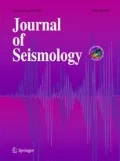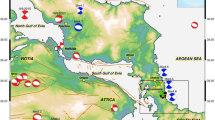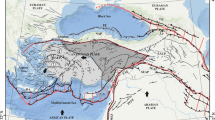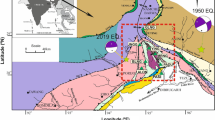Abstract
We use the recorded seismicity, confined to the Dead Sea basin and its boundaries, by the Dead Sea Integrated Research (DESIRE) portable seismic network and the Israel and Jordan permanent seismic networks for studying the mechanisms of earthquakes in the Dead Sea basin. The observed seismicity in the Dead Sea basin is divided into nine regions according to the spatial distribution of the earthquakes and the known tectonic features. The large number of recording stations and the adequate station distribution allowed the reliable determinations of 494 earthquake focal mechanisms. For each region, based on the inversion of the observed polarities of the earthquakes, we determine the focal mechanisms and the associated stress tensor. For 159 earthquakes, out of the 494 focal mechanisms, we could determine compatible fault planes. On the eastern side, the focal mechanisms are mainly strike-slip mechanism with nodal planes in the N-S and E-W directions. The azimuths of the stress axes are well constrained presenting minimal variability in the inversion of the data, which is in agreement with the Eastern Boundary fault on the east side of the Dead Sea basin and what we had expected from the regional geodynamics. However, larger variabilities of the azimuthal and dip angles are observed on the western side of the basin. Due to the wider range of azimuths of the fault planes, we observe the switching of σ1 and σ2 or the switching of σ2 and σ3 as major horizontal stress directions. This observed switching of stress axes allows having dip-slip and normal mechanisms in a region that is dominated by strike-slip motion.









Similar content being viewed by others
References
Aldersons F, Ben-Avraham Z, Hofstetter A, Kissling E, Al-Yazjeen T (2003) Lower-crustal strength under the Dead Sea basin from local earthquake and rheological modeling. Earth Planet Sci Lett 214:129–142
Al-Zoubi A, Ten Brink US (2001) Salt diapirs in the Dead Sea basin and their relationship to Quaternary extensional tectonics. Marine Petrol Geol 18:779–797
Al-Zoubi A, Shulman H, Ben-Avraham Z (2002) Seismic reflection profiles across the southern Dead Sea basin. Tectonophysics 346:61–69
Al-Zoubi A, Heinrichs T, Sauterb M, Ten Brink U (2007) The northern end of the Dead Sea basin: geometry from reflection seismic evidence. Tectonophysics 434:55–69
Arieh E, Rotstein Y, Peled U (1982) The Dead Sea earthquake of April 23, 1979. Seismol Soc Am Bull 72:1627–1634
Armijo R, Carey E, Cisternas A (1982) The inverse problem in microtectonics and the separation of tectonic phases. Tectonophysics 82:145–160
Badawy A, Horváth F (1999) Recent stress field of the Sinai subplate region. Tectonophysics 304:385–403
Baer G, Schattner U, Wachs D, Sandwell D, Wdowinski S, Frydman S (2002) The lowest place on Earth is subsiding-an InSAR (interferometric synthetic aperture radar) perspective. Geol Soc Amer Bull 114:12–23
Bartov Y (1999) The geology of the Lisan Formation in the central Dead Sea basin. M.Sc. thesis, Hebrew Univ Jerusalem (in Hebrew, English abstr.)
Bartov Y, Agnon A, Enzel Y, Stein M (2006) Late Quaternary faulting and subsidence in the central Dead Sea basin. Israel J Earth Sci 55:17–31
Ben-Avraham Z (1997) Geophysical framework of the Dead Sea: structure and tectonic, in The Dead Sea, the lake and its settings. In: Niemi TM, Ben-Avraham Z, Gat JR (eds) Oxford monographs on geology and geophysics, vol 36. Oxford University Press, New York, pp 22–35
Ben-Avraham Z, Zoback MD (1992) Transform-normal extension and asymmetric basins: an alternative to pull-apart models. Geology 20:423–426
Ben-Avraham Z, Ten Brink U (1989) Transverse faults and segmentation of basins within the Dead Sea rift. J Afr Earth Sci 8:603–616
Ben-Avraham Z, Schubert G (2006) Deep “drop down” basin in the southern Dead Sea. Earth Planet Sci Lett 251:254–263
Ben-Avraham Z, Garfunkel Z, Lazar M (2008) Geology and evolution of the southern Dead Sea fault with emphasis on subsurface structure. Ann Rev Earth Planet Sci 36:357–387
Ben-Avraham Z, Lyakhovsky V, Schubert G (2010) Drop-down formation of deep basins along the Dead Sea and other strike-slip fault systems. Geophys J Int 181:185–197. doi:10.1111/j.1365-246X.2010.04525.x
Ben-Menahem A, Vered M, Nur A (1976) Tectonics, seismicity and structure of the Afro-Euroasian junction - the breaking of an incoherent plate. Phys Earth Planet Inter 12:1–50
Braeuer B, Bauer K (2015) A new interpretation of seismic tomography in the southern Dead Sea basin using neural network clustering techniques., Geophys Res Lett submitted
Braeuer B, Asch G, Hofstetter A, Haberland C, Jaser D, El-Kelani R, Weber M (2012a) Microseismicity distribution in the southern Dead Sea area and its implications on the structure of the basin. Geophys J Int 188:873–878
Braeuer B, Asch G, Hofstetter A, Haberland C, Jaser D, El-Kelani R, Weber M (2012b) High resolution local earthquake tomography of the southern Dead Sea area. Geophys J Int 191:881–897. doi:10.1111/j.1365-246X.2012.05668.x
Braeuer B, Asch G, Hofstetter A, Haberland Ch, Jaser D, El-Kelani R, Weber M (2014) Detailed seismicity analysis revealing the dynamics of the southern Dead Sea area. J Seismol 18. doi:10.1007/s10950-014-9441-4
Choi S, Götze H-J, Meyer U, and DESIRE Group (2011) 3-D density modelling of underground structures and spatial distribution of salt diapirism in the Dead Sea basin. Geophys J Int 184:1131–1146. doi:10.1111/j.1365-246X.2011.04939.x
Csato I, Kendall C, Nairn A, Baum G (1997) Sequence stratigraphic interpretations in the southern Dead Sea basin. Israel. Geol Soc Amer Bull 109:1485–1501
DeNatale G, Ferraro A, Virieux J (1991) A probability method for local earthquake focal mechanisms. Geophys Res Lett 18:613–616
Deves M, King GCP, Klinger Y, Agnon A (2011) Localised and distributed deformation in the lithosphere: modelling the Dead Sea region in 3 dimensions. Earth Planet Sci Lett 308:172–184. doi:10.1016/j.epsl.2011.05.044
Dorbath L, Evans K, Cuenot N, Valley B, Charléty J, Frogneux M (2010) The stress field at Soultz-sous-Forêts from focal mechanisms of induced seismic events: Cases of the wells GPK2 and GPK3. C R Geoscience 342:600–606
Eyal Y (1996) Stress field fluctuations along the Dead Sea rift since the middle Miocene. Tectonics 15:157–170
Eyal Y, Reches Z (1983) Tectonic analysis of the Dead Sea rift region since the Late-Cretaceous based on mesostructures. Tectonics 2:167–185
Freund R, Garfunkel Z, Zak I, Goldberg M, Weissbrod T, Derin B (1970) The shear along the Dead Sea rift. Philos Trans R Soc London, Ser A 267:105–127
Frieslander U (2000) The structure of the Dead Sea transform emphasizing the Arava using new geophysical data. Ph.D. Thesis, The Hebrew Univ, Jerusalem, p 101
Gardosh M, Reches Z, Garfunkel Z (1990) Holocene tectonic deformation along the western margins of the Dead Sea. Tectonophysics 180:123–137
Garfunkel Z (1981) Internal structure of the Dead Sea leaky transform (rift) in relation to plate kinematics. Tectonophysics 80:81–108
Garfunkel Z, Ben-Avraham Z (1996) The structure of the Dead Sea basin. Tectonophysics 266:155–176
Garfunkel Z, Zak I, Freund R (1981) Active faulting in the Dead Sea rift. Tectonophysics 80:1–26
Gephart J, Forsyth D (1984) An improved method for determining the regional stress tensor using focal mechanism data: application to the San Fernando earthquake sequence. J Geophys Res 89:9305–9320
Gilat A (1991) Oversized U-shaped canyon development at the edge of rotating blocks due to wrench faulting on margins of the Dead Sea graben. Terra Nova 3:638–647
Ginzburg A, Ben-Avraham Z (1997) A seismic refraction study of the north basin of the Dead Sea, Israel. Geophys Res Lett 24:2063–2066
Ginzburg A, Reshef M, Ben-Avraham Z, Schattner U (2006) The style of transverse faulting in the Dead Sea basin from seismic reflection data: the Amazyahu fault. Isr J Earth Sci 55:129–139
Hardebeck J, Hauksson E (2001) The crustal stress field in southern California and its implications for fault mechanics. J Geophys Res 106:21859–21882
Hardebeck J, Michael A (2006) Damped regional-scale stress inversions: methodology and examples for southern California and the Coalinga aftershock sequence. J Geophys Res 111, B11310. doi:10.1029/2005JB004144
Hauksson E (1994) State of stress from focal mechanism before and after the 1992 Landers earthquake sequence. Bull Seis Soc Amer 84:917–934
Hofstetter A (2014) On the reliability of focal plane solutions using first motion readings. J Seismol 18:181–197. doi:10.1007/s10950-013-9410-3
Hofstetter A, Dorbath C (2014) Teleseismic travel times residuals across the Dead Sea basin. J Geophys Res - Solid Earth 119. doi:10.1002/2014JB011357
Hofstetter A, Feldman L, Rotstein Y (1991) Crustal structure of Israel: constraints from teleseismic and gravity data. Geophys J Intern 104:371–379
Hofstetter A, Dorbath C, Rybakov M, Goldshmidt V (2000) Crustal and upper mantle structure across the Dead Sea rift and Israel from teleseismic P wave tomography and gravity data. Tectonophysics 327:37–59
Hofstetter A, Klinger Y, Amrat A, Rivera L, Dorbath L (2007) Stress inversion and focal mechanisms along the Levantine Fault from seismological data. Tectonophysics 429:165–181
Hofstetter A, Gitterman Y, Pinsky V, Kraeva N, Feldman L (2008) Seismological observations of the Northern Dead Sea basin earthquake on 11/2/2004. Isr J Earth Sci 57:101–124
Hofstetter A, Dorbath C, Calò M (2012) Crustal structure of the Dead Sea basin from local earthquake tomography. Geophys J Intern 189:554–568
Kashai E, Crocker P (1987) Structural geometry and evolution of the Dead Sea-Jordan rift system as deduced from new subsurface data. Tectonophysics 141:33–60
Kaverina A, Lander A, Prozorov A (1996) Global creepex distribution and its relation to earthquake-source geometry and tectonic origin. Geophys J Inter 125:249–265
Kaviani A, Hofstetter A, Rumpker G, Weber M (2013) Investigation of seismic anisotropy beneath the Dead Sea fault using dense networks of broadband stations. J Geophys Res 118. doi:10.1002/jgrb.50250
Kisslinger C, Bowman D, Koch K (1981) Procedures for computing focal mechanisms from local SV/P data. Bull Seismol Soc Am 71:1719–1729
Kostrov V (1974) Seismic moment and energy of earthquakes and seismic flow of rock. Izv Acad Sci USSR Phys Earth 1:23–40
Koulakov I, Sobolev S (2006) Moho depth and three-dimensional P and S structure of the crust and uppermost mantle in the Eastern Mediterranean and Middle East derived from tomographic inversion of local ISC data. Geophys J Int 164:218–235. doi:10.1111/j.1365-246X.2005.02791.x
Kraeva N, Hofstetter A, Meirova T (2009) Waveform moment tensor inversion of earthquakes in Israel and adjacent regions. Isr J Earth Sci 58:177–192
Larsen BD, Ben-Avraham Z, Shulman H (2002) Fault and salt tectonics in the southern Dead Sea basin. Tectonophysics 346:71–90
Lazar M (2004) Tectonic processes along the northern edges of pull-apart basins in the Dead Sea rift: a case study from the Northern Dead Sea, Ph.D. Thesis, Tel Aviv University., p 156
Lazar M, Ben-Avraham Z, Schattner U (2006) Formation of sequential basins along a strike–slip fault—geophysical observations from the Dead Sea basin. Tectonophysics 421:53–69
Le Beon M, Klinger Y, Amrat A-Q, Agnon A, Dorbath L, Baer G, Ruegg J-C, Charade O, Mayyas O (2008) Slip rate and locking depth from GPS profiles across the southern Dead Sea Transform. J Geophys Res 113, B11403. doi:10.1029/07JB005280
Lund B, Slunga R (1999) Stress tensor inversion using detailed microearthquake information and stability constraints: applications to Olfus in southwest Iceland. J Geophys Res 104:14947–14964
Marco S, Stein M, Agnon A, Ron H (1996) Long term earthquake clustering: a 50,000 years paleoseismic record in the Dead Sea graben. J Geophys Res 101:6179–6191
Masson F, Hamiel Y, Agnon A, Klinger Y, Deprez A (2015) Variable behavior of the Dead Sea Fault along the southern Arava segment from GPS measurements. Compt Rend Geoscience 347:161–169, http://dx.doi.org/10.1016/j.crte.2014.11.001
McKenzie D (1969) The relation between fault plane solutions for earthquakes and the directions of the principal stresses. Bull Seismol Soc Amer 59:591–601
Mechie J, K. Abu-Ayyash, Z. Ben-Avraham, R. El-Kelani, I. Qabbani, M. Weber, and DESIRE Group (2009) Crustal structure of the southern Dead Sea basin derived from project DESIRE wide-angle seismic data. Geophys J Int 178:457–478
Mechie J, Abu-Ayyash K, Ben-Avraham Z, El-Kelani R, Mohsen A, Rümpker G, Saul J, Weber M (2005) Crustal shear velocity structure across the Dead Sea Transform from two-dimensional modelling of DESERT project explosion seismic data. Geophys J Int 160:910–924. doi:10.1111/j.1365-246X.2005.02526.x
Michael AJ (1984) Determination of stress from slip data: faults and folds. J Geophys Res 89:11517–11526
Michael AJ (1987a) The use of focal mechanisms to determine stress: a control study. J Geophys Res 92:357–368
Michael AJ (1987b) Stress rotation during the Coalinga aftershock sequence. J Geophys Res 92:963–7979
Mohsen A, Asch G, Mechie J, Kind R, Hofstetter A, Weber M, Stiller M, Abu-Ayyash K (2011) Crustal structure of the Dead Sea basin (DSB) from a receiver function analysis. Geophys J Int 184:463–476
Neev D, Hall JK (1979) Geophysical investigations in the Dead Sea. Sedimentary Geol 23:209–238
Palano M, Imprescia P, Gresta S (2013) Current stress and strain-rate fields across the Dead Sea Fault System: constraints from seismological data and GPS observations. Earth Planet Sci Lett 369–370:305–316
Pe’eri S, Wdowinski S, Shtibelman A, Bechor N, Bock Y, Nikolaidis R, Van Domselaar M (2002) Current plate motion across the Dead Sea Fault from three years of continuous GPS monitoring. Geophys Res Lett 29:1697–1700
Petrunin AG, Sobolev SV (2006) What controls thickness of sediments and lithospheric deformation at a pull-apart basin? Geology 34:389–392
Petrunin AG, Sobolev SV (2008) Three-dimensional numerical models of the evolution of pull-apart basins. Physics Earth Planet Inter 171:387–399
Rau RJ, Wu F, Shin TC (1996) Regional network focal mechanism determination using 3D velocity model and the SH/P amplitude ratio. Bull Seis Soc Amer 86:1270–1283
Reasenberg P, Oppenheimer D (1985) FPFIT, FPPLOT and FPPGAPE: Fortran computer programs for calculating and displaying earthquake fault-plane solutions. USGS Open-File Rept 85–739
Reches Z, Hoexter D (1981) Holocene seismic and tectonic activity in the Dead Sea area: the Dead Sea rift. Tectonophysics 80:235–254
Rivera L, Cisternas A (1990) Stress tensor and fault plane solution for a population of earthquakes. Bull Seism Soc Amer 80:600–614
Rotstein Y, Bartov Y, Hofstetter A (1991) Active compressional tectonics in the Jericho area, Dead Sea rift. Tectonophysics 198:239–259
Sagy A, Reches Z, Agnon A (2003) Hierarchic three-dimensional structure and slip partitioning in the western Dead Sea pull-apart. Tectonics 22:1004–1007
Salamon A, Hofstetter A, Garfunkel Z, Ron H (1996) Seismicity of Eastern Mediterranean region: perspective of the Sinai subplate. Tectonophysics 263:293–307
Salamon A, Hofstetter A, Garfunkel Z, Ron H (2003) Seismotectonics of the Sinai subplate-the Eastern Mediterranean region. Geophys J Int 155:149–173
Shamir G (2006) The active structure of the Dead Sea depression. Spec Pap Geol Soc Am 401:15–32
Shamir G, Eyal Y, Bruner I (2005) Localized versus distributed shear in transform plate boundary zones: the case of the Dead Sea transform in the Jericho Valley. Geochem Geophys Geosyst 6:1–21
Smit J, Brun J-P, Fort X, Cloetingh S, Ben-Avraham Z (2008) Salt tectonics in pull-apart basins with application to the Dead Sea Basin. Tectonophysics 449:1–16. doi:10.1016/j.tecto.07.12.004
Ten Brink U, Flores C (2012) Geometry and subsidence history of the Dead Sea basin: A case for fluid-induced mid-crustal shear zone? J Geophys Res 117. doi:10.1029/2011JB008711
Ten Brink U, Ben-Avraham Z, Bell R, Hassouneh M, Coleman D, Andersean G, Tibor G, Coakley B (1993) Structure of the Dead Sea pull-apart basin from gravity analyses. J Geophys Res 98:21887–21894
Udias A, Buforn E, Brillinger D, Bolt B (1982) Joint statistical determination of fault-plane parameters. Phys Earth Planet Inter 30:178–184
Van Eck T, Hofstetter A (1989) Microearthquake activity in the Dead Sea depression. Geophys J Int 99:605–620
Van Eck T, Hofstetter A (1990) Fault geometry and spatial clustering of microearthquakes along the Dead Sea-Jordan fault zone. Tectonophysics 180:15–27
Walters R, Parsons B, Wright T (2014) Constraining crustal velocity fields with InSAR for Eastern Turkey: Limits to the block-like behavior of Eastern Anatolia. J Geophys Res 119. doi:10.1002/2013JB010909
Weber M, Abu‐Ayyash K, Abueladas A, Agnon A, Alasonati‐Tašárová Z, Al‐Zubi H, Babeyko A, Bartov Y, Bauer K, Bedrosian PA, Ben‐Avraham Z, Bock G, Ebbing J, El‐Kelani R, Förster A, Garfunkel Z, Haberland C, Hassouneh M, Hofstetter A, Hoffmann‐Rothe A, Jaser D, Kesten D, Kind R, Koch O, Maercklin N, Masarweh R, Mechie J, Mohsen A, Oberhänsli R, Oreshin S, Petrunin A, Ritter O, Rümpker G, Rybakov M, Scherbaum F, Schulze A, Sobolev S, Stiller M, Trela C, Wetzel U, Wylegalla K (2009a) Anatomy of the Dead Sea Transform from lithospheric to microscopic scale. Rev Geophys 47, RGR2002, 44 pp
Weber M, Alasonati-Tašárová Z, Abu-Ayyash K, Ben-Avraham Z, Choi S, Darwish J, El-Kelani R, Garfunkel Z, Götze H-J, Grünthal G, Hofstetter A, Kesten D, Mechie J, Meyer U, Mohsen A, Paschke M, Petrunin A, Ryberg T, Sobolev S, Stiller M, DESERT and DESIRE Groups (2009b) Results of geophysical studies across the Dead Sea Transform: the Arava/Araba Valley and the Dead Sea Basin, Israel. J Earth Sci 58:147–161. doi:10.1560/IJES.58.3-4.147
Weber M, Abu-Ayyash K, Ben-Avraham Z, Choi S, Darwish J, El-Kelani R, Garfunkel Z, Götze H-J, Hofstetter A, Koulakov I, Laske G, Mechie J, Meyer U, Mohsen A, Petrunin A, Rioseco E, Ryberg T, Rümpker G, Sobolev S, DESERT and DESIRE Groups (2014) Geophysical Studies of the Lithosphere along the Dead Sea Transform, in the Dead Sea Transform Fault System: Reviews, pp. 39-52, Garfunkel Z, Ben-Avraham Z, Kagan E, (Eds.) Springer, doi:10.1007/978-94-017-8872-4
Wessel P, Smith W (1991) Free software helps maps and display data. EOS Trans AGU 72:441
Wetzler N, Sagy A, Marco S (2014) The association of micro-earthquake clusters with mapped faults in the Dead Sea basin. J Geophys Res 119:8312–8330. doi:10.1002/2013JB010877
Zak I, Freund R (1981) Asymmetry and basin migration in the Dead Sea rift. Tectonophysics 80:27–38
Acknowledgements
The study was supported by EOST, Univ. of Strasbourg, France, Chaire Gutenberg Strasbourg, France, ORSTOM, France, and the Earth Sciences and Research Administration, Ministry of Energy and Water, Israel. A. Hofstetter thanks the Région Alsace and the Communauté Urbaine de Strasbourg for the award of a Gutenberg Excellence Chair. Some figures in this report were prepared using the GMT program (Wessel and Smith 1991). We thank the Geophysical Instrument Pool Potsdam for providing the instruments for the DESIRE experiments and GEOFON for data archiving (http://geofon-open2.gfz-potsdam.de/doi/network/Z4/2006). We thank V. Avirav and A. Polozov for technical help in the graphics. We thank the two reviewers for their useful and constructive comments that improved the manuscript.
Author information
Authors and Affiliations
Corresponding author
Rights and permissions
About this article
Cite this article
Hofstetter, A., Dorbath, C., Dorbath, L. et al. Stress tensor and focal mechanisms in the Dead Sea basin. J Seismol 20, 669–699 (2016). https://doi.org/10.1007/s10950-015-9550-8
Received:
Accepted:
Published:
Issue Date:
DOI: https://doi.org/10.1007/s10950-015-9550-8




